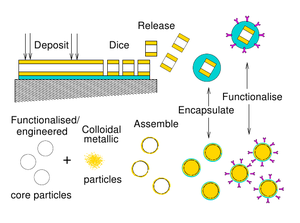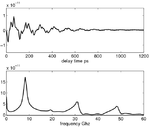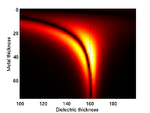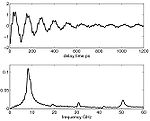Difference between revisions of "Nanoscale Ultrasonic Transducers"
(→Plate devices) |
|||
| Line 7: | Line 7: | ||
<br style="clear:both" /> | <br style="clear:both" /> | ||
==Plate devices== | ==Plate devices== | ||
| + | |||
| + | |||
| + | {|align="center" | ||
| + | |[[file:Model_ito.png |thumb|150px|alt=alt text|model of mechanical motion]] | ||
| + | |[[file:BNC_opticalmodel.PNG |thumb|150px|alt=alt text| optical model]] | ||
| + | |} | ||
We have successfully modelled and built plate like transducers and tested them in our picosecond laser ultrasound experiment. The experimentally recorded signal agrees remarkably well with the modelled response. The modelling and manufacturing process for the nanoparticle transducers has been established and devices are being created so that they can be measured in the experiment. In the future we hope to encapsulate and functionalise the devices so that they can be used in targeted measurements within cells. | We have successfully modelled and built plate like transducers and tested them in our picosecond laser ultrasound experiment. The experimentally recorded signal agrees remarkably well with the modelled response. The modelling and manufacturing process for the nanoparticle transducers has been established and devices are being created so that they can be measured in the experiment. In the future we hope to encapsulate and functionalise the devices so that they can be used in targeted measurements within cells. | ||
| + | {|align="center" | ||
| + | |[[file:BNC_ito_poly_patch.jpg |thumb|150px|alt=alt text|Experimental result]] | ||
| + | |[[file:BNC_hair2highlightred.PNG |thumb|150px|alt=alt text|Transducer Attached to hair]] | ||
| + | |} | ||
<br style="clear:both" /> | <br style="clear:both" /> | ||
| + | |||
==self assembled nanoparticles== | ==self assembled nanoparticles== | ||
Revision as of 08:22, 20 April 2011
We have created new ultrasonic transducers operating at the nanoscale with frequencies in the gigahertz range and with wavelengths smaller than those of visible light. These will enable the diagnostic power of ultrasonics to be used at the nanoscale.
These new transducers are so small it is impractical to communicate with them electrically. Instead we have devised a non contact method of talking to them using short pulses of laser light. They work by absorbing one laser beam, the pump, which causes them to resonate delivering high frequency ultrasound waves into the sample. We detect the interaction of this sound with the transducer with another laser beam, the probe, which is reflected back to the detector from the different layers that make up the device.
Plate devices
We have successfully modelled and built plate like transducers and tested them in our picosecond laser ultrasound experiment. The experimentally recorded signal agrees remarkably well with the modelled response. The modelling and manufacturing process for the nanoparticle transducers has been established and devices are being created so that they can be measured in the experiment. In the future we hope to encapsulate and functionalise the devices so that they can be used in targeted measurements within cells.




